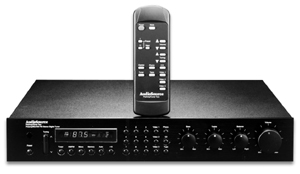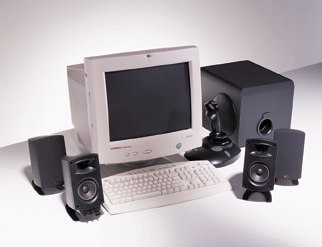
Multimedia Speakers
Living Phat in the Land Of Be
Hey, man, tired of waiting for Windows to get its act together so you can finally rip and burn those RIAA-incendiary files without your PC breaking into a sweat and not needing a Pentium VII with a terabyte of memory to handle it all?
And please, forget about LINUX. it's just too old, man. No matter what Linus and his open source bros do, there is still no getting around the fact that the PC LINUX crib is built on a decades old UNIX architecture.
If you want to live ripping phat in the land of the new millennium PC, then BeOS is the only call you can make. BeOS is a thoroughly modern, multithreaded, protected memory, preemptive multitasking, 64-bit OS with a new kernel design. It makes Windows and LINUX both look real old, real fast. To find out more, check out It Ain't ME, Babe.
And to get the maximum audio benefit out of the superlative BeOS system, you need the right listening gear, so let's take a quick spin to see what's totally cool. My favorite desktop PC multimedia system is the LFT-11. It's made by a traditional high-end audio company called Eminent Technologies (www.eminent-tech.com). The ultra thin LFT-11 speakers are push-pull planars (LFT="linear field transducer.") With the LFT-11, Eminent has successfully shrunk the architectural design of its highly regarded, 6 foot tall full range planar speakers into a 9.5" tall, 6.25" wide, just 3/4" thick magnetically shielded desktop speaker. The unique, patented design of this diminutive dipole speaker (the sound emanates front and rear) uses a very thin sheet of aluminum, which is laminated onto a .5 thick Mylar sheet. Via a silk-screening/chemical etching process, a voice coil grid is etched right onto the aluminum sheet. To move the acoustical air, this LFT-11 "planar sandwich" uses shielded magnets to propel the approximately 2-mil thick voice coil grid backwards and forwards.

The LFT-11's pre-attached panel speaker wires come with nicely solid banana plugs, and the system uses a very sturdy, lock-on circular fitting for coupling a separate, extra cost amplifier into the accompanying sub/crossover box. That's right, Bunky, these are not self-powered speakers, despite their $499 asking price. Eminent will sell you a NAD310 integrated amplifier rated at 25 watts RMS per channel for an extra hundred bucks, but my preferred LFT-11 partner amplifier is the Audio Source (www.audiosource.net) AMP Two. The $399 AMP Two pumps out 80 watts/channel. It's a terrific sounding little unit, regardless of price. Ordinarily, you would use a preamp with the AMP Two, and a great companion piece is the AudioSource PreAmp/Tuner Two. This is a very versatile control unit cum AM/FM tuner that offers excellent sound quality at, for the audio high-end anyway, a bargain basement price of $499. However, the AMP Two amplifier also comes with two rotary input signal level controls on its front panel, so if you can supply the appropriate input voltage (.8V) to drive this diminutive dynamo to its full rated power (and most PC sound systems can), you can do without the preamp.


The Eminent blonde-colored wooden sub matches the wood frames of the satellites, while the sub's side panels are covered in gloss black Formica. The entire LFT-11 system, including the passive woofer box with its two 6.5" Audax conventional voice coil speakers (crossed over at 200Hz), is claimed to have a frequency response that stretches from 35Hz to 20Khz, +/- 4dB.
The transparency and accuracy of the LFT-11 satellites, plus their 3D dipole soundstage, are exactly what you would expect from any well designed planar speaker coming out of the traditional audio high-end -- it's exceptional. Surprisingly, on get busy, really big orchestral pieces, the paltry panels can move some serious air. However, like most planars in general, the LFT-11 mini-panels are not head banger, rock the house down speakers.
The Eminent subwoofer box sonically integrates quite well with the LFT-11 Sats, providing them a solid bass foundation. Overall, the LFT-11 Sats are very flat in their on-axis frequency response, which to some ears, might make them sound thin or bright at lower listening levels. So don't touch those tone controls - just crank up the volume.
We've also just cranked up the LFT-11 total system price to $1,400 when you use both the AMP Two and matching Preamp. Ouch! But we wouldn't first tempt you and then just leave you hanging, would we? Fortunately, Eminent Technology has licensed its patented planar design to Sonigistix, the makers of Monsoon PC multimedia systems. I had the chance to compare my all-up LFT-11 system against two of the Monsoon models, the MM-1000 and the MM-700 systems. Appearance-wise, the all-black, industrial design Monsoons are much sexier looking than their wooden Eminent counterparts, which look old world frumpy in comparison. Also unlike the Eminent LFT-11's, all the Monsoon speakers are self-powered.
In
the case of the MM-1000, the woofer has a 25 watt amplifier and the two Sats
get 12.5 watts each, or 50 watts complete. Monsoon notes these 50 watts are
"short term, continuous average," which sounds like an oxymoron to me. On
the MM-1000 sub woofer, there is a volume control, a bass volume control and
"bass punch" button that offers a 6-dB boost at 55 Hz. In marked contrast
to the LFT-11 full flash rig, the MM-1000 retails for only $199. The MM-700
retails for just $149, which gets six watts less than its bigger brother,
for 44 watts, total. The 700 sub also doesn't get the el-boosto-bass punch
control of the MM-1000.
While they both share the same basic planar technology, the satellite enclosure
designs of the two Monsoon systems are quite different. Frankly, I prefer
the Bauhaus postmodern look of the wire base frame MM-700 satellites to the
all-plastic cases of the MM-1000 units. But much more interestingly, I also
preferred the sound of the MM-700's to their more expensive siblings. While
the MM-700's didn't have the bass wallop of the MM-1000's, they were better
balanced overall. The MM-700 midrange, especially, was smoother and the speakers
threw up a bigger, more 3-D soundstage than the MM-1000. My hunch (and it's
only a very nonscientific hunch) is that the thick wire frame enclosure of
the MM-700 is more rigid, and thereby yields improved sonics due to less flexing
of the planar ribbon. Naturally, the marketing people and engineers at Sonigistix
will dispute all this. But their bitch is your bargain. Either way, both Monsoon
systems rank as true sonic pleasures. And both the MM-1000 and the MM-700
fared extremely well in comparison to the all-up Eminent rig. (And no, I'm
not letting go any time soon of my LFT-11/AudioSource system).
But OK, so you are a hard core gamer and less concerned about musical refinement and instead want a bass-pounding, crank 'em up, lease breaking system. No problem. Stop what you are doing and immediately buy the Klipsch "ProMedi" v.2-400 THX-certified multimedia system. This bad boy is spec'd at 110dB SPL at the listening position. This eardrum busting SPL is fueled by a 160 watt subwoofer, and four (!) satellites speakers that get 60 watts apiece, for a make-the-neighbors-nuts total of 400 watts. We've just shot past the AudioSource AMP 2, and left the Monsoons gasping in the low wattage dust. Klipsch is an old-time maker of great audio gear and is famous for its horn speakers. Unlike the Eminent planars, the Klipsch satellites are conventional looking even though their "Micro Tractix Horn" looks kind of funky.

The
Klipsch midrange isn't as refined and uncolored as the LFT-11s or either of
the Monsoons, and the 3-D imaging isn't as good as any of those little planars,
but that's not what the ProMedia is about. Because, oh mama, does this system
rock! The ProMedia is a take no prisoners system, which, if your remote gaming
rivals could hear it, would have them soiling their shorts and fleeing in
panic. The grin alone is worth the ProMedia's $250 price of admission (submission?).
Between
the remarkable BeOS and all this great audio gear, PC multimedia doesn't get
any better than this. So go download BeOS 5.0 (the personal edition is free
at www.be.com/products/freebeos),
strap on a pair of great cans or crank up the sub/Sats, and live large, muchachos.
Copyright 2000, Franco Vitaliano, All Rights Reserved
21st, The VXM Network, https://vxm.com